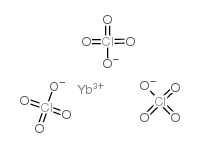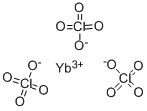高氯酸镱(III) ,Ytterbium (III) perchlorate ,50% aqueous solution,99.9%-Yb(REO)
产品编号:Bellancom-B280684| CAS NO:13498-08-3| 分子式:H2Cl3O13Yb| 分子量:489.4071
本网站销售的所有产品仅用于工业应用或者科学研究等非医疗目的,不可用于人类或动物的临床诊断或者治疗,非药用,非食用,
| 英文名称 | Ytterbium (III) perchlorate |
|---|---|
| CAS编号 | 13498-08-3 |
| 产品密度 | 1.474 g/mL at 25 °C |
| 精确质量 | 470.78400 |
| PSA | 222.81000 |
| LogP | 0.64290 |
| 外观性状 | liquid | colorless |
| 蒸气压 | 0.12 psi ( 20 °C) |
| 溶解性 | Insoluble in water. |
| 稳定性 | 常温常压下稳定 避免的物料 还原剂 易氧化材料 水溶液与碱金属 碱土金属和许多有机无机的活性化学药品是不相溶的 |
| 储存条件 | 常温密闭,阴凉通风干燥 |
相关文档
化学品安全说明书(MSDS)
下载MSDS质检证书(COA)
相关产品
| 危害码 (欧洲) | O: Oxidizing agent;C: Corrosive; |
|---|---|
| 风险声明 (欧洲) | R8 |
| 安全声明 (欧洲) | 17-26-36/37/39-45 |
| 危险品运输编码 | UN 3211 5.1/PG 2 |
| 包装等级 | II |
| 危险类别 | 5.1 |
|
Section 1: Product Identification Chemical Name:Ytterbium (III) perchlorate, 50% aqueous solution (99.9%-Yb) (REO) CAS Registry Number:13498-08-3 Formula:Yb(ClO4)3 EINECS Number:none Chemical Family:metal perchlorate salt Synonym:Perchloric acid, Ytterbium(III) salt, aqueous solution
Section 2: Composition and Information on Ingredients IngredientCAS NumberPercentACGIH (TWA)OSHA (PEL) Title Compound13498-08-350%no datano data water7732-18-550%no datano data Section 3: Hazards Identification Irritating to eyes, skin and respiratory tract. May be harmful if swallowed. May affect thyroid and kidney Emergency Overview: functions Primary Routes of Exposure:Ingestion Eye Contact:Causes moderate irritation of the eyes. Skin Contact:Causes moderate irritation of the skin. Inhalation:Irritating to the nose, mucous membranes and respiratory tract. No specific information is available on the physiological effects of ingestion. May cause gastrointestinal Ingestion: irritation, nausea, and vomiting. Acute Health Affects:Irritating to skin, eyes and respiratory tract. Chronic Health Affects:Perchlorates reversibly inhibit thyroid iodine uptake. Kidney function may be affected. NTP:No IARC:No OSHA:No SECTION 4: First Aid Measures Immediately flush the eyes with copious amounts of water for at least 10-15 minutes. A victim may need Eye Exposure: assistance in keeping their eye lids open. Get immediate medical attention. Wash the affected area with water. Remove contaminated clothes if necessary. Seek medical assistance if Skin Exposure: irritation persists. Remove the victim to fresh air. Closely monitor the victim for signs of respiratory problems, such as difficulty Inhalation: in breathing, coughing, wheezing, or pain. In such cases seek immediate medical assistance. Seek medical attention immediately. Keep the victim calm. Give the victim water (only if conscious). Induce Ingestion: vomiting only if directed by medical personnel. SECTION 5: Fire Fighting Measures Flash Point:no data Autoignition Temperature:no data Explosion Limits:no data Extinguishing Medium:Water spray Keep sample area wet until fire is completely out. Once dry, product becomes a powerful oxidant, and will act Special Fire Fighting Procedures: as a source of oxygen to support combustion. Hazardous Combustion andIf involved in a fire this material may emit corrosive hydrogen chloride fumes. Decomposion Products: Unusual Fire or Explosion Hazards: May decompose explosively if allowed to dry under fire fighting conditions. Do not mix with combustibles. SECTION 6: Accidental Release Measures Spill and Leak Procedures:Adsorb the liquid into vermiculite or other non combustible adsorbent. SECTION 7: Handling and Storage Handling and Storage:Store in a tightly sealed container in a cool place. SECTION 8: Exposure Controls and Personal Protection Eye Protection:Always wear approved safety glasses when handling a chemical substance in the laboratory. Skin Protection:Wear protective clothing and gloves. Ventilation:Handle the material in an efficient fume hood. If ventilation is not available a respirator should be worn. The use of respirators requires a Respiratory Respirator: Protection Program to be in compliance with 29 CFR 1910.134. Ventilation:Handle the material in an efficient fume hood. Additional Protection:No additional protection required. SECTION 9: Physical and Chemical Properties Color and Form:colorless liq. Molecular Weight:471.39 Melting Point:no data Boiling Point:no data Vapor Pressure:not applicable Specific Gravity:no data Odor:none Solubility in Water:soluble SECTION 10: Stability and Reactivity Stability:Air and moisture stable liquid Hazardous Polymerization:no hazardous polymerization Conditions to Avoid:Any contact with combustible matter, followed by evaporation of water. None as aqueous solution. If dried, avoid reducing agents, organic matter, active metals, hydrazine, and Incompatibility: strong acids Decomposition Products:Oxygen, Ytterbium oxide, hydrogen chloride, SECTION 11: Toxicological Information RTECS Data:No information available in the RTECS files. Carcinogenic Effects:No data available Mutagenic Effects:No data available Tetratogenic Effects:No data available SECTION 12: Ecological Information Ecological Information:No data available SECTION 13: Disposal Considerations Disposal:Dispose of according to local, state and federal regulations. SECTION 14: Transportation Shipping Name (CFR):Perchlorates, Inorganic, Aqueous solution, N.O.S. Hazard Class (CFR):5.1 Additional Hazard Class (CFR):NA Packaging Group (CFR):II UN ID Number (CFR):UN# 3211 Shipping Name (IATA):Perchlorates, Inorganic, Aqueous solution, N.O.S. Hazard Class (IATA):5.1 Additional Hazard Class (IATA):NA Packaging Group (IATA):II UN ID Number (IATA):UN# 3211 SECTION 15: Regulatory Information TSCA:Not listed in the TSCA inventory. SARA (Title 313):Title compound not listed. Second Ingredient:none SECTION 16 - ADDITIONAL INFORMATION N/A |








 浙公网安备 33010802013016号
浙公网安备 33010802013016号